Melarhaphe neritoides (Linnaeus, 1758)
Small periwinkle| Native range | All suitable habitat | Point map | Year 2050 |

|
| This map was computer-generated and has not yet been reviewed. |
| Melarhaphe neritoides AquaMaps Data sources: GBIF OBIS |
Google image | No image available for this species;
drawing shows typical species in Littorinidae.
Classification / Names Common names | Synonyms | CoL | ITIS | WoRMS
Gastropoda | Littorinimorpha | Littorinidae
Environment: milieu / climate zone / depth range / distribution range Ecology
Benthic; depth range 0 - 200 m (Ref. 2754). Temperate
Distribution Countries | FAO areas | Ecosystems | Occurrences | Introductions
Western Indian Ocean, Northeast Atlantic and the Mediterranean. Subtropical to temperate climates.
Length at first maturity / Size / Weight / Age
Maturity: Lm ? range ? - ? cmmax. reported age: 12 years (Ref. 8702)
Life cycle and mating behavior Maturity | Reproduction | Spawning | Eggs | Fecundity | Larvae
Main reference
References | Coordinator | Collaborators
Demir, M. 2003 Shells of mollusca collected from the seas of Turkey. Turkey Journal of Zoology 27:101-140. (Ref. 2754)
IUCN Red List Status
(Ref. 130435: Version 2025-1)
CITES status (Ref. 108899)
CMS (Ref. 116361)
Threat to humans
Human uses
| FishSource |
Tools
More information
Diet composition
Food consumption
Predators
Max. ages / sizes
Length-weight rel.
Length-length rel.
Length-frequencies
Mass conversion
Abundance
Internet sources
BHL | BOLD Systems | CISTI | DiscoverLife | FAO(Publication : search) | Fishipedia | GenBank (genome, nucleotide) | GloBI | Gomexsi | Google Books | Google Scholar | Google | PubMed | Tree of Life | Wikipedia (Go, Search) | Zoological Record



